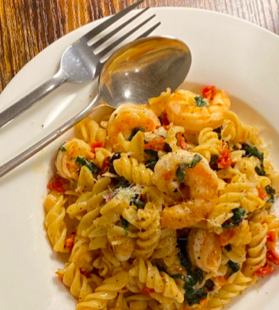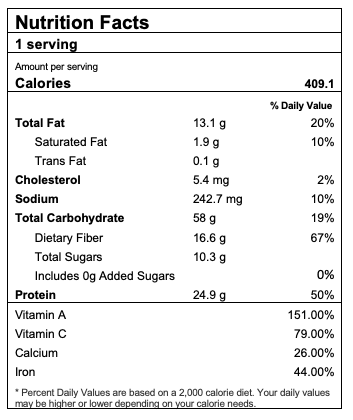by YeaJin Kim, Dietetic Intern
This pasta recipe is a gluten-free and vegetarian dish that can be made with just a few ingredients. You can easily turn this into a complete vegan meal just by swapping or omitting one ingredient – parmesan cheese. By using chickpea pasta, this recipe is rich in plant-based protein. Moreover, this is a quick recipe that is ready in 30 minutes. Most of the ingredients may already be in your pantry, and the main ingredients, ‘sun-dried tomatoes’ and ‘chickpea pasta’ can be found in any grocery store. Packed with vitamins, minerals, fibers, and antioxidants, it may become your favorite alternative to classic tomato sauce pasta!
Ingredient Highlights
Chickpea pasta: Chickpea pasta or any bean type pasta is usually made with ground bean flour, and xanthan gum or tapioca as a thickener. Thus, this pasta contains more plant-based protein and fiber than white flour pasta. Beans can provide cardiovascular, metabolic and colon protective effects and anti-inflammatory effects [i].
Collard greens: Collard greens are a part of Brassica oleracea family that includes vegetables such as cabbage and broccoli [ii]. This vegetable is usually eaten cooked because its leaves have a stringy texture. Just like other dark-green vegetables, collards are an excellent source of vitamin K, vitamin C, calcium and fiber, making it beneficial for bone health, the immune system, and gut health [iii].
Sun-dried tomatoes: Sun-dried tomatoes have their own unique flavor and texture while maintaining the nutrient contents of raw tomatoes. The deep-red pigment of tomato skin contains strong antioxidants called lycopene, with sun-dried tomatoes having an even higher content of lycopene [iv].
Olive oil: Olive oil helps reduce risk of heart disease and mortality in individuals with heart-related diseases [v]. Several studies show that polyphenols in olive oil promote antiatherogenic HDL-cholesterol function while decreasing atherogenic LDL-cholesterol, all of which could be related to improving lipid profile of the body [vi, vii].
Recipe
Pasta with Collards and Sun-dried Tomatoes
Serves: 4

Ingredients
- 10 oz (3 ½ cups) short chickpea pasta, dry
- ½ bunch (1 pound) collard greens, washed and stemmed
- Bowl of ice water
- 2 Tbsp olive oil
- 1.5 small shallots, chopped
- 3 cloves garlic, minced
- ¼ tsp red pepper flakes
- 6 pieces (10g) sun-dried tomatoes, minced
- 1 cup peas, frozen
- ½ cup pasta cooking water
- 4 Tbsp (1oz) parmesan, grated
Instructions
- Roll up the stemmed collard greens and cut into thin ribbons
- Prepare boiling water; blanch collard greens until tender for about 2 minutes
- Using sieve, transfer the collards in cold water and set aside
- In the same boiling water, cook the pasta according to package instructions
- Reserve half a cup of pasta water; drain and set aside the cooked pasta
- Toss slightly with olive oil to prevent from sticking
- Heat a large size skillet pan over medium high heat, and add olive oil
- Reduce heat to low and add shallots and minced garlic; cook until fragrant
- Season with salt, black pepper, and red pepper flakes; cook until fragrant
- Add sun-dried tomatoes into the cooked shallots and garlic oil and cook for a minute
- Add collard greens, peas, and reserved pasta water; Simmer on medium heat for a couple of minutes
- Add pasta into the skillet with grated parmesan
- Toss gently with a tong and serve pasta on plates
- Enjoy!
Notes:
- You can also use other bean type pasta such as black bean, edamame, lentil or mung bean
- Feel free to add in any protein such as rotisserie chicken or shrimp
- Collard greens may be substituted with any dark leafy greens such as kale, spinach, mustard greens, and swiss chard or any fresh herbs such as basil or arugula by adding at the last step before serving
- For a vegan option, omit parmesan or swap with nutritional yeast

References:
[i] Mullins AP, Arjmandi BH. Health Benefits of Plant-Based Nutrition: Focus on Beans in Cardiometabolic Diseases. Nutrients. 2021;13(2):519. doi:10.3390/nu13020519
[ii] Farnham, Mark W. (May 1996). “Genetic Variation among and within United States Collard Cultivars and Landraces as Determined by Randomly Amplified Polymorphic DNA Markers”. Journal of the American Society for Horticultural Science. 121 (3): 374–379. doi:10.21273/jashs.121.3.374. ISSN 0003-1062.
[iii] Farnham, Mark W.; Lester, Gene E.; Hassell, Richard (2012-08-01). “Collard, mustard and turnip greens: Effects of genotypes and leaf position on concentrations of ascorbic acid, folate, β-carotene, lutein and phylloquinone”. Journal of Food Composition and Analysis. 27 (1): 1–7. doi:10.1016/j.jfca.2012.04.008. ISSN 0889-1575.
[iv] Shi J, Le Maguer M. Lycopene in tomatoes: chemical and physical properties affected by food processing. Crit Rev Biotechnol. 2000;20(4):293-334. doi:10.1080/07388550091144212
[v] Guasch-Ferré M, Hu FB, Martínez-González MA, et al. Olive oil intake and risk of cardiovascular disease and mortality in the PREDIMED Study. BMC Med. 2014;12:78. Published 2014 May 13. doi:10.1186/1741-7015-12-78
[vi] Hernáez Á, Fernández-Castillejo S, Farràs M, et al. Olive oil polyphenols enhance high-density lipoprotein function in humans: a randomized controlled trial. Arterioscler Thromb Vasc Biol. 2014;34(9):2115-2119. doi:10.1161/ATVBAHA.114.303374
[vii] Hernáez Á, Remaley AT, Farràs M, et al. Olive Oil Polyphenols Decrease LDL Concentrations and LDL Atherogenicity in Men in a Randomized Controlled Trial. J Nutr. 2015;145(8):1692-1697. doi:10.3945/jn.115.211557
